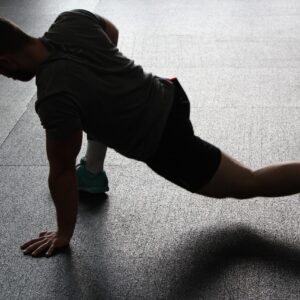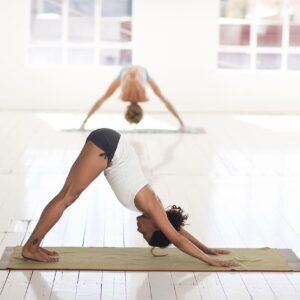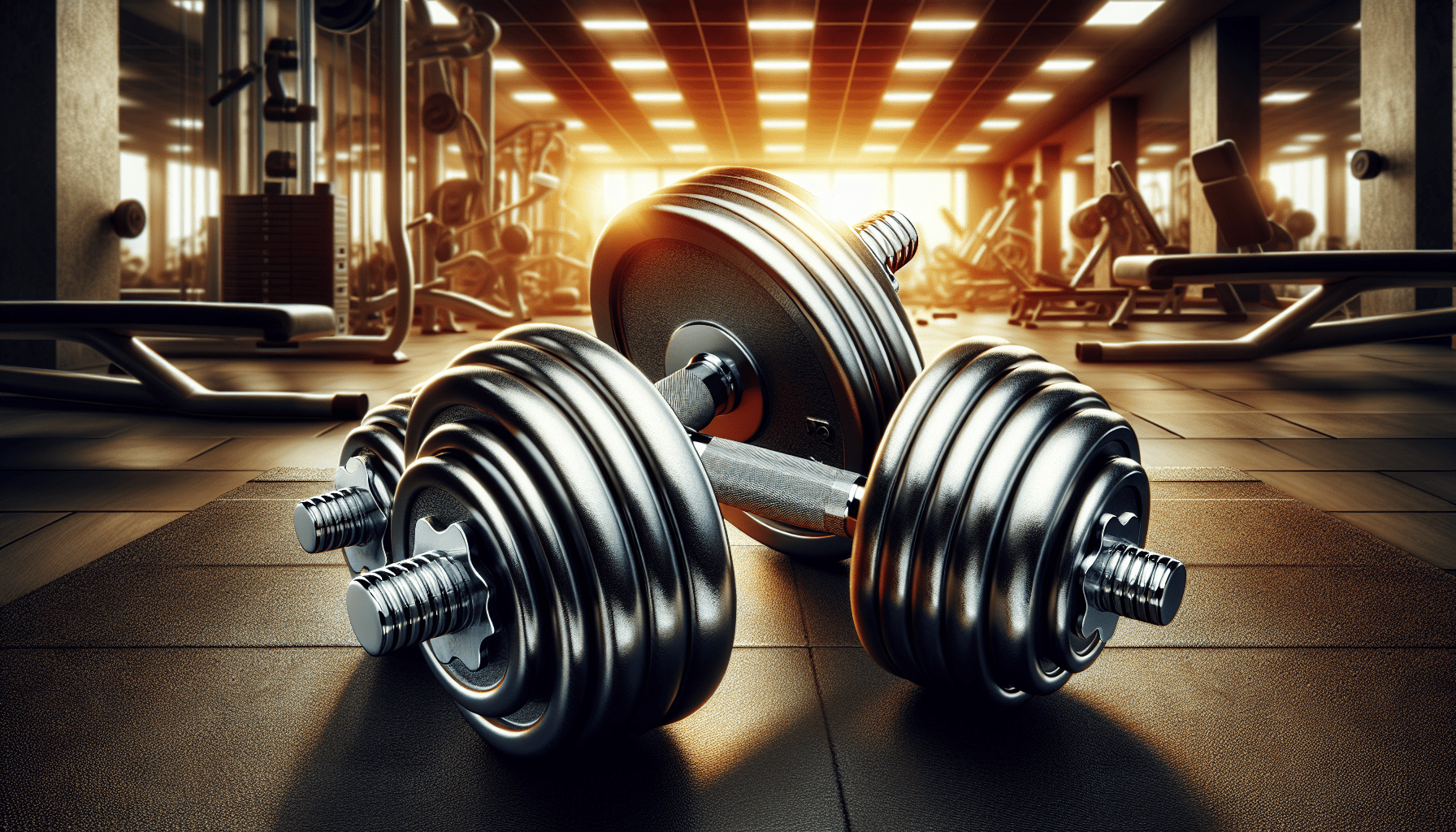Whether you’re new to the gym or just looking to switch up your workout routine, these 5 beginner gym routines are the perfect solution for quick and easy workouts. With a witty twist on traditional exercises, these routines will keep you engaged and motivated as you work towards your fitness goals. So grab your gym bag and get ready to sweat, because these beginner-friendly routines are about to take your workouts to the next level.
Full Body Workout
Warm-up exercises
Before diving into your full body workout, it’s essential to warm up your muscles to prevent injury and maximize performance. Start with a light five to ten-minute cardio activity such as jogging, cycling, or jumping jacks. This will increase your heart rate and get your blood flowing, preparing your body for the upcoming exercises.
Compound exercises
Compound exercises are an excellent choice for a full body workout as they engage multiple muscle groups at once, promoting overall strength and muscle development. Examples of compound exercises include squats, deadlifts, push-ups, and pull-ups. These movements require coordination and recruit a large number of muscles, providing a comprehensive training stimulus.
Isolation exercises
While compound exercises are fantastic for targeting multiple muscles, isolation exercises allow you to focus on specific muscle groups. These exercises can isolate smaller muscles and improve muscle definition. Some popular isolation exercises include bicep curls, tricep extensions, lateral raises, and hamstring curls. Adding a few isolation exercises to your routine can help you achieve a well-rounded full body workout.
Cool-down exercises
Once you have completed your workout, it’s important to cool down your body gradually. This helps to reduce muscle soreness and stiffness. Perform light cardio exercises such as jogging or walking for about five minutes to gradually lower your heart rate. Follow this with static stretching, focusing on the muscle groups you just worked. This will aid in muscle recovery and flexibility.
Upper Body Workout
Warm-up exercises
Before targeting your upper body, it’s crucial to warm up the muscles to prevent injury. Start with arm circles, shoulder rolls, and neck stretches. These will loosen up your upper body and increase blood flow to the area.
Chest exercises
To sculpt a strong and defined chest, incorporate exercises like bench presses, push-ups, and dumbbell flyes into your routine. These exercises will target your pectoral muscles, helping you develop upper body strength and a well-rounded physique.
Back exercises
A strong back is essential for maintaining good posture, preventing back pain, and enhancing overall athleticism. Incorporate exercises such as rows, lat pulldowns, and deadlifts into your workout routine. These exercises will strengthen your upper, middle, and lower back, giving you a well-developed and confident posture.
Shoulder exercises
Shoulder exercises are crucial for building stability and strength in the upper body. Incorporate exercises like overhead presses, lateral raises, and front raises to target your deltoids and increase shoulder mobility. Strong and well-developed shoulders will not only improve your posture but also enhance your athletic performance.
Bicep exercises
When it comes to arm workouts, bicep exercises are a go-to. Include exercises like bicep curls, hammer curls, and chin-ups in your routine. These exercises will target your biceps, giving you those sought-after toned and defined arms.
Tricep exercises
To balance out your arm workout, it’s essential to target the triceps as well. Tricep exercises such as tricep dips, tricep pushdowns, and skull crushers will help you build strength and definition in the back of your arms. Well-developed triceps will complement your biceps, giving you a balanced and aesthetic upper body.
Cool-down exercises
After completing your upper body workout, it’s crucial to cool down your muscles gradually. Perform light stretches targeting your chest, back, shoulders, biceps, and triceps to promote muscle recovery and flexibility. Take your time during this cool-down period to reap the full benefits of your workout.
Lower Body Workout
Warm-up exercises
Before diving into your lower body workout, warm up your leg muscles to prevent injury. Try exercises such as leg swings, lunges, and high knee marches to increase blood flow to your lower body and prepare your muscles for the upcoming workout.
Squat exercises
Squats are a staple exercise for any lower body routine as they target multiple muscle groups simultaneously. Incorporate variations like goblet squats, sumo squats, and Bulgarian split squats into your routine to engage your quadriceps, hamstrings, glutes, and calves. Squats not only build strength but also improve overall lower body stability.
Lunge exercises
Lunges are excellent for targeting the quadriceps, glutes, and hamstrings. Front lunges, reverse lunges, and walking lunges are effective variations to include in your lower body workout. Lunges also help improve balance, stability, and unilateral leg strength.
Deadlift exercises
Deadlifts are a compound exercise that primarily targets the posterior chain, including the hamstrings, glutes, and lower back. Incorporate variations like Romanian deadlifts, sumo deadlifts, and trap bar deadlifts into your routine to challenge different muscle groups. Deadlifts not only build strength but also improve overall lower body power and stability.
Calf exercises
Don’t neglect your calf muscles when it comes to lower body workouts. Calves add definition to your legs and contribute to overall lower body strength. Include exercises like calf raises, seated calf raises, and calf jumps in your routine. These exercises will target your gastrocnemius and soleus muscles, giving you strong and sculpted calves.
Cool-down exercises
To complete your lower body workout, it’s essential to cool down your muscles gradually. Perform light stretches focusing on your quadriceps, hamstrings, glutes, and calves. Cooling down properly will help reduce muscle soreness and promote recovery.
Cardio Workout
Warm-up exercises
Before engaging in a cardio workout, it’s crucial to warm up your body to prevent injury. Begin with light cardio exercises such as jogging in place, high knees, and butt kicks. This will increase your heart rate and warm up your muscles in preparation for the upcoming cardio exercises.
Treadmill exercises
The treadmill is an excellent option for cardiovascular training. Try exercises like jogging, running, or interval training on the treadmill to improve your cardiovascular endurance. Adjust the speed and incline according to your fitness level and goals. Treadmill exercises are effective for burning calories and improving overall cardiovascular health.
Stationary bike exercises
Stationary bikes provide a low-impact alternative for cardio workouts. Whether you prefer a steady-state ride or an interval training session, the stationary bike offers versatility and effectiveness. Adjust the resistance and speed to challenge yourself and increase your cardio endurance.
Elliptical exercises
The elliptical machine provides a full-body workout that is gentle on the joints. It targets the legs, glutes, arms, and core simultaneously. Control the resistance and speed to make your elliptical workout more challenging and enjoyable.
Jumping rope exercises
Jumping rope is a perfect cardio exercise that can be done anywhere. Whether you’re at the gym or in your own backyard, jumping rope is an effective way to get your heart rate up and burn calories. It also improves coordination and agility. Start with basic jumps and progress to more advanced techniques as you become more skilled.
Cool-down exercises
After completing your cardio workout, it’s important to gradually cool down your body. Perform low-intensity activities like walking or slow jogging for a few minutes to allow your heart rate to return to normal. Follow this with light stretches targeting the muscles you used during your cardio workout. Cooling down properly will help prevent muscle soreness and promote a faster recovery.
Core Workout
Warm-up exercises
Before targeting your core, warm up your muscles with exercises like torso twists, side bends, and cat-cow stretches. This will increase blood flow to the area and prepare your core muscles for the upcoming workout.
Plank exercises
Planks are a fantastic way to engage your entire core, including your abs, back, and stabilizing muscles. Start with basic forearm planks and progress to side planks and plank variations like mountain climbers or plank jacks. Planks not only strengthen your core but also improve posture and stability.
Crunch exercises
Crunches are a classic core exercise that targets the upper abdominals. Incorporate traditional crunches, reverse crunches, and bicycle crunches into your routine. These exercises help to develop strong and defined abs.
Russian twist exercises
Russian twists are great for targeting the obliques, or side abdominal muscles. Use a medicine ball, dumbbell, or bodyweight to perform this exercise. Russian twists not only strengthen the obliques but also improve rotational stability.
Leg lift exercises
To target the lower abs, include leg lift exercises in your core routine. Leg lifts can be performed on the floor or using a captain’s chair or hanging bar. This exercise strengthens the lower abdominal muscles and helps to improve overall core stability.
Cool-down exercises
After completing your core workout, take a few minutes to cool down your muscles gradually. Perform light stretches targeting your abs, obliques, and lower back. Cooling down properly will aid in muscle recovery and flexibility.
Circuit Training
Warm-up exercises
Before starting a circuit training session, it’s important to warm up your muscles and increase your heart rate. Perform exercises such as jumping jacks, high knees, or jogging in place for five to ten minutes. This will prepare your body for the intense workout ahead.
Full body circuit
A full body circuit involves performing a series of exercises targeting different muscle groups with little to no rest in between. It helps improve cardiovascular endurance, build strength, and burn calories. Design your full body circuit by selecting compound exercises such as squats, lunges, push-ups, and rows. Perform each exercise for a certain number of repetitions or a set amount of time before moving onto the next one. Repeat the circuit for several rounds depending on your fitness level and goals.
Upper body circuit
An upper body circuit specifically targets the muscles in your arms, chest, shoulders, and back. Include exercises like push-ups, tricep dips, bicep curls, and shoulder presses in your circuit. Perform each exercise for a set amount of time or repetitions before transitioning to the next. Remember to maintain proper form throughout.
Lower body circuit
The lower body circuit targets your quadriceps, hamstrings, glutes, and calves. Exercises like squats, lunges, deadlifts, and calf raises can be included in your lower body circuit. Adjust the intensity and difficulty of each exercise according to your fitness level. Complete each exercise before moving onto the next, and aim to increase the number of rounds as you progress.
Cardio circuit
Cardio circuits are designed to elevate your heart rate and improve cardiovascular endurance. Incorporate exercises like jumping jacks, burpees, high knees, and mountain climbers into your circuit. Perform each exercise for a set amount of time or repetitions, and aim to minimize rest periods between exercises. Vary the intensity and type of cardio exercises to keep your circuit challenging and engaging.
Core circuit
A core circuit targets the muscles in your abs, obliques, and lower back. Include exercises such as plank variations, crunches, Russian twists, and leg lifts in your circuit. Focus on maintaining proper form and engaging your core muscles throughout each exercise. By performing a variety of core exercises, you will strengthen and tone your midsection.
Cool-down exercises
After completing your circuit training session, it’s important to cool down your body gradually. Perform light cardio exercises or walk for a few minutes to lower your heart rate. Follow this with static stretches targeting the major muscle groups you worked during the circuit. Cooling down properly will aid in muscle recovery and prevent post-workout soreness.
Strength Training
Warm-up exercises
Before engaging in strength training exercises, it’s essential to warm up your muscles and increase blood flow to the targeted areas. Perform dynamic stretches and movements that mimic the exercises you’re planning to do. For example, if you’re going to perform squats, warm up your hips with bodyweight squats or lunges.
Compound exercises
Compound exercises involve using multiple muscles and joints simultaneously, making them highly effective for building overall strength. Squats, deadlifts, bench presses, and overhead presses are examples of compound exercises that engage multiple muscle groups. Incorporate these exercises into your strength training routine to maximize muscle growth and functional strength.
Isolation exercises
Isolation exercises target specific muscle groups, allowing you to focus on muscle definition and development. Bicep curls, tricep extensions, lateral raises, and calf raises are examples of isolation exercises that help to isolate individual muscles. Including isolation exercises in your routine can help you achieve a well-rounded and aesthetically pleasing physique.
Progressive overload
Progressive overload is a principle in strength training that involves gradually increasing the stress placed on the muscles to promote adaptation and growth. This can be achieved by increasing the weight, repetitions, or sets over time. By progressively challenging your muscles, you’ll see consistent progress and avoid hitting plateaus in your strength training journey.
Cool-down exercises
After completing your strength training session, it’s important to cool down your muscles gradually. Perform light cardio exercises such as walking or cycling to lower your heart rate and promote circulation. Follow this with static stretches targeting the major muscle groups you worked during your strength training session. Cooling down properly will aid in muscle recovery and flexibility.
Flexibility Training
Warm-up exercises
Before engaging in flexibility training, it’s crucial to warm up your muscles and increase blood flow to the targeted areas. Perform dynamic stretches and movements that target the muscles you plan to stretch. This will help to prevent injury and improve the effectiveness of your stretches.
Static stretching
Static stretching involves holding a stretch for a prolonged period, typically 20-30 seconds. It helps improve flexibility and muscle elasticity. Focus on major muscle groups such as the hamstrings, quadriceps, calves, chest, shoulders, and back. Remember to breathe deeply and relax into each stretch without bouncing.
Dynamic stretching
Dynamic stretching involves active movements that lengthen and warm up the muscles. Unlike static stretching, dynamic stretches are performed in a controlled and flowing manner without holding the end position. Examples of dynamic stretches include leg swings, arm circles, and walking lunges. Incorporate dynamic stretching at the beginning of your flexibility training routine to increase range of motion and prepare your muscles for more intense stretching.
Yoga
Yoga is a holistic practice that combines physical postures (asanas), breathing techniques (pranayama), and meditation. It improves flexibility, strength, balance, and mental well-being. Whether you prefer a gentle Hatha yoga class or a more vigorous Vinyasa flow, incorporating yoga into your flexibility training routine can provide numerous benefits for both your body and mind.
Pilates
Pilates is a low-impact exercise system that focuses on core strength, flexibility, and overall body awareness. It emphasizes precise movements and controlled breathing, targeting deep abdominal muscles, the pelvic floor, and spinal stability. Pilates exercises help improve flexibility, posture, and muscular strength without placing excessive stress on the joints.
Cool-down exercises
After completing your flexibility training session, it’s important to cool down your muscles gradually. Perform light stretching exercises targeting the major muscle groups you worked during your flexibility routine. Focus on gentle stretches and deep breathing to promote muscle recovery and relaxation. Cooling down properly will also help reduce post-workout muscle soreness.
Balance and Stability Training
Warm-up exercises
Before engaging in balance and stability training, it’s important to warm up your muscles and increase blood flow to the targeted areas. Perform dynamic exercises that involve balance, such as single-leg exercises or bosu ball exercises. This will help activate the muscles involved in balance and prepare your body for the upcoming exercises.
Single leg exercises
Single leg exercises are a great way to improve balance, stability, and lower body strength. Examples include single-leg squats, lunges, and step-ups. Focus on maintaining proper form and engaging your core throughout each exercise. Single leg exercises challenge your balance and stability, enhancing your overall athleticism.
Bosu ball exercises
The Bosu ball is a versatile tool that can be used to improve balance, stability, and core strength. Incorporate exercises like squats, lunges, push-ups, and planks onto the Bosu ball to challenge your stability and engage your muscles in a unique way. Bosu ball exercises add an element of instability, making them excellent for functional training.
Swiss ball exercises
Swiss balls, also known as stability balls, can be used to improve balance, stability, and core strength. Exercises like stability ball squats, planks, bridges, and seated twists are effective in targeting multiple muscle groups while engaging the body’s stabilizer muscles. Swiss ball exercises are a fun and challenging addition to your balance and stability training routine.
Balance board exercises
Balance boards are great tools for improving proprioception, coordination, and balance. Incorporate exercises like squats, lunges, and single-leg stands onto the balance board. These exercises challenge your balance and engage the muscles involved in stabilizing your body. Balance board exercises are an effective way to enhance your overall balance and stability.
Cool-down exercises
After completing your balance and stability training session, it’s important to cool down your body gradually. Perform light stretches targeting your lower body and core to promote muscle recovery and flexibility. Take your time during this cool-down period to help your body relax and restore its balance. Cooling down properly will aid in preventing muscle soreness and injuries.
Functional Training
Warm-up exercises
Before engaging in functional training exercises, it’s crucial to warm up your muscles and increase blood flow to the targeted areas. Perform dynamic exercises that involve functional movements, such as squats, lunges, or jumping jacks. This will help activate the muscles involved and prepare your body for the upcoming exercises.
Functional exercises
Functional exercises simulate everyday movements or sports-specific actions, improving overall strength, mobility, and coordination. Incorporate exercises like squats, lunges, step-ups, kettlebell swings, and medicine ball throws to develop functional strength and stability. Focus on maintaining proper form and engaging your core during each exercise. Functional training enhances your ability to perform real-life activities effectively.
Interval training
Interval training involves alternating high-intensity exercise with periods of rest or lower intensity exercise. Incorporate interval training into your functional workout by combining exercises like burpees, kettlebell swings, mountain climbers, and box jumps. This not only improves cardiorespiratory fitness but also challenges your muscles and enhances their functional abilities.
Agility ladder exercises
Agility ladder exercises are an effective way to improve footwork, coordination, and agility. Set up an agility ladder and practice exercises like ladder drills, lateral hops, and quick feet drills. By incorporating agility ladder exercises into your functional training routine, you’ll enhance your ability to move quickly and efficiently.
Cool-down exercises
After completing your functional training session, it’s important to cool down your muscles gradually. Perform light aerobic exercises like jogging in place or walking to allow your heart rate to return to normal. Follow this with static stretches targeting the major muscle groups you worked during your functional workout. Cooling down properly will aid in muscle recovery and flexibility.
Incorporating a variety of workouts into your fitness routine allows you to target different muscle groups, improve overall strength and fitness levels, and prevent boredom. By following these comprehensive workout outlines and expanding on each section, you’ll be well on your way to achieving your health and fitness goals in a fun and effective way. Remember to consult with a fitness professional before starting any new exercise program, especially if you have any underlying health conditions or injuries. Stay consistent, listen to your body, and enjoy the journey towards a stronger and healthier you!




